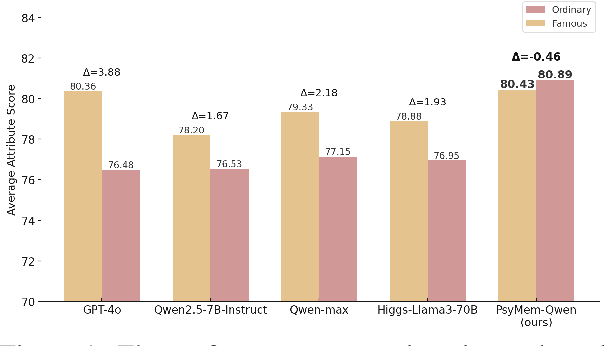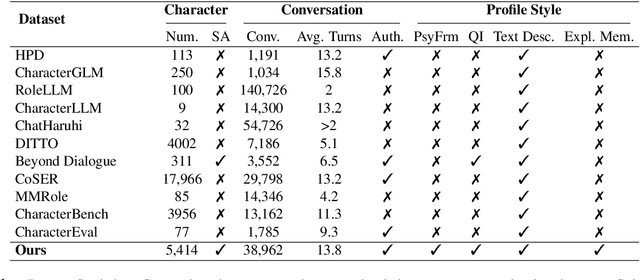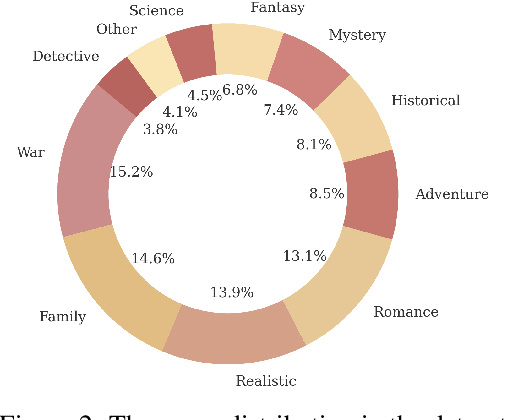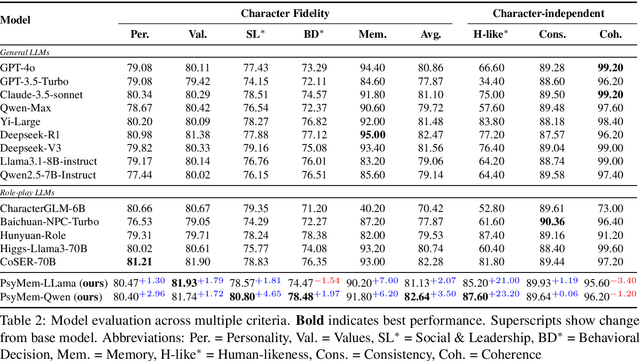Yuan Zhang
OmniHuman-1.5: Instilling an Active Mind in Avatars via Cognitive Simulation
Aug 26, 2025Abstract:Existing video avatar models can produce fluid human animations, yet they struggle to move beyond mere physical likeness to capture a character's authentic essence. Their motions typically synchronize with low-level cues like audio rhythm, lacking a deeper semantic understanding of emotion, intent, or context. To bridge this gap, \textbf{we propose a framework designed to generate character animations that are not only physically plausible but also semantically coherent and expressive.} Our model, \textbf{OmniHuman-1.5}, is built upon two key technical contributions. First, we leverage Multimodal Large Language Models to synthesize a structured textual representation of conditions that provides high-level semantic guidance. This guidance steers our motion generator beyond simplistic rhythmic synchronization, enabling the production of actions that are contextually and emotionally resonant. Second, to ensure the effective fusion of these multimodal inputs and mitigate inter-modality conflicts, we introduce a specialized Multimodal DiT architecture with a novel Pseudo Last Frame design. The synergy of these components allows our model to accurately interpret the joint semantics of audio, images, and text, thereby generating motions that are deeply coherent with the character, scene, and linguistic content. Extensive experiments demonstrate that our model achieves leading performance across a comprehensive set of metrics, including lip-sync accuracy, video quality, motion naturalness and semantic consistency with textual prompts. Furthermore, our approach shows remarkable extensibility to complex scenarios, such as those involving multi-person and non-human subjects. Homepage: \href{https://omnihuman-lab.github.io/v1_5/}
THAT: Token-wise High-frequency Augmentation Transformer for Hyperspectral Pansharpening
Aug 11, 2025Abstract:Transformer-based methods have demonstrated strong potential in hyperspectral pansharpening by modeling long-range dependencies. However, their effectiveness is often limited by redundant token representations and a lack of multi-scale feature modeling. Hyperspectral images exhibit intrinsic spectral priors (e.g., abundance sparsity) and spatial priors (e.g., non-local similarity), which are critical for accurate reconstruction. From a spectral-spatial perspective, Vision Transformers (ViTs) face two major limitations: they struggle to preserve high-frequency components--such as material edges and texture transitions--and suffer from attention dispersion across redundant tokens. These issues stem from the global self-attention mechanism, which tends to dilute high-frequency signals and overlook localized details. To address these challenges, we propose the Token-wise High-frequency Augmentation Transformer (THAT), a novel framework designed to enhance hyperspectral pansharpening through improved high-frequency feature representation and token selection. Specifically, THAT introduces: (1) Pivotal Token Selective Attention (PTSA) to prioritize informative tokens and suppress redundancy; (2) a Multi-level Variance-aware Feed-forward Network (MVFN) to enhance high-frequency detail learning. Experiments on standard benchmarks show that THAT achieves state-of-the-art performance with improved reconstruction quality and efficiency. The source code is available at https://github.com/kailuo93/THAT.
DiffCap: Diffusion-based Real-time Human Motion Capture using Sparse IMUs and a Monocular Camera
Aug 08, 2025Abstract:Combining sparse IMUs and a monocular camera is a new promising setting to perform real-time human motion capture. This paper proposes a diffusion-based solution to learn human motion priors and fuse the two modalities of signals together seamlessly in a unified framework. By delicately considering the characteristics of the two signals, the sequential visual information is considered as a whole and transformed into a condition embedding, while the inertial measurement is concatenated with the noisy body pose frame by frame to construct a sequential input for the diffusion model. Firstly, we observe that the visual information may be unavailable in some frames due to occlusions or subjects moving out of the camera view. Thus incorporating the sequential visual features as a whole to get a single feature embedding is robust to the occasional degenerations of visual information in those frames. On the other hand, the IMU measurements are robust to occlusions and always stable when signal transmission has no problem. So incorporating them frame-wisely could better explore the temporal information for the system. Experiments have demonstrated the effectiveness of the system design and its state-of-the-art performance in pose estimation compared with the previous works. Our codes are available for research at https://shaohua-pan.github.io/diffcap-page.
MedReadCtrl: Personalizing medical text generation with readability-controlled instruction learning
Jul 10, 2025Abstract:Generative AI has demonstrated strong potential in healthcare, from clinical decision support to patient-facing chatbots that improve outcomes. A critical challenge for deployment is effective human-AI communication, where content must be both personalized and understandable. We introduce MedReadCtrl, a readability-controlled instruction tuning framework that enables LLMs to adjust output complexity without compromising meaning. Evaluations of nine datasets and three tasks across medical and general domains show that MedReadCtrl achieves significantly lower readability instruction-following errors than GPT-4 (e.g., 1.39 vs. 1.59 on ReadMe, p<0.001) and delivers substantial gains on unseen clinical tasks (e.g., +14.7 ROUGE-L, +6.18 SARI on MTSamples). Experts consistently preferred MedReadCtrl (71.7% vs. 23.3%), especially at low literacy levels. These gains reflect MedReadCtrl's ability to restructure clinical content into accessible, readability-aligned language while preserving medical intent, offering a scalable solution to support patient education and expand equitable access to AI-enabled care.
Beyond Attention or Similarity: Maximizing Conditional Diversity for Token Pruning in MLLMs
Jun 12, 2025Abstract:In multimodal large language models (MLLMs), the length of input visual tokens is often significantly greater than that of their textual counterparts, leading to a high inference cost. Many works aim to address this issue by removing redundant visual tokens. However, current approaches either rely on attention-based pruning, which retains numerous duplicate tokens, or use similarity-based pruning, overlooking the instruction relevance, consequently causing suboptimal performance. In this paper, we go beyond attention or similarity by proposing a novel visual token pruning method named CDPruner, which maximizes the conditional diversity of retained tokens. We first define the conditional similarity between visual tokens conditioned on the instruction, and then reformulate the token pruning problem with determinantal point process (DPP) to maximize the conditional diversity of the selected subset. The proposed CDPruner is training-free and model-agnostic, allowing easy application to various MLLMs. Extensive experiments across diverse MLLMs show that CDPruner establishes new state-of-the-art on various vision-language benchmarks. By maximizing conditional diversity through DPP, the selected subset better represents the input images while closely adhering to user instructions, thereby preserving strong performance even with high reduction ratios. When applied to LLaVA, CDPruner reduces FLOPs by 95\% and CUDA latency by 78\%, while maintaining 94\% of the original accuracy. Our code is available at https://github.com/Theia-4869/CDPruner.
Fast ECoT: Efficient Embodied Chain-of-Thought via Thoughts Reuse
Jun 09, 2025Abstract:Embodied Chain-of-Thought (ECoT) reasoning enhances vision-language-action (VLA) models by improving performance and interpretability through intermediate reasoning steps. However, its sequential autoregressive token generation introduces significant inference latency, limiting real-time deployment. We propose Fast ECoT, an inference-time acceleration method that exploits the structured and repetitive nature of ECoT to (1) cache and reuse high-level reasoning across timesteps and (2) parallelise the generation of modular reasoning steps. Additionally, we introduce an asynchronous scheduler that decouples reasoning from action decoding, further boosting responsiveness. Fast ECoT requires no model changes or additional training and integrates easily into existing VLA pipelines. Experiments in both simulation (LIBERO) and real-world robot tasks show up to a 7.5% reduction in latency with comparable or improved task success rate and reasoning faithfulness, bringing ECoT policies closer to practical real-time deployment.
PathFL: Multi-Alignment Federated Learning for Pathology Image Segmentation
May 28, 2025Abstract:Pathology image segmentation across multiple centers encounters significant challenges due to diverse sources of heterogeneity including imaging modalities, organs, and scanning equipment, whose variability brings representation bias and impedes the development of generalizable segmentation models. In this paper, we propose PathFL, a novel multi-alignment Federated Learning framework for pathology image segmentation that addresses these challenges through three-level alignment strategies of image, feature, and model aggregation. Firstly, at the image level, a collaborative style enhancement module aligns and diversifies local data by facilitating style information exchange across clients. Secondly, at the feature level, an adaptive feature alignment module ensures implicit alignment in the representation space by infusing local features with global insights, promoting consistency across heterogeneous client features learning. Finally, at the model aggregation level, a stratified similarity aggregation strategy hierarchically aligns and aggregates models on the server, using layer-specific similarity to account for client discrepancies and enhance global generalization. Comprehensive evaluations on four sets of heterogeneous pathology image datasets, encompassing cross-source, cross-modality, cross-organ, and cross-scanner variations, validate the effectiveness of our PathFL in achieving better performance and robustness against data heterogeneity.
Faithful Group Shapley Value
May 25, 2025Abstract:Data Shapley is an important tool for data valuation, which quantifies the contribution of individual data points to machine learning models. In practice, group-level data valuation is desirable when data providers contribute data in batch. However, we identify that existing group-level extensions of Data Shapley are vulnerable to shell company attacks, where strategic group splitting can unfairly inflate valuations. We propose Faithful Group Shapley Value (FGSV) that uniquely defends against such attacks. Building on original mathematical insights, we develop a provably fast and accurate approximation algorithm for computing FGSV. Empirical experiments demonstrate that our algorithm significantly outperforms state-of-the-art methods in computational efficiency and approximation accuracy, while ensuring faithful group-level valuation.
One-Step Diffusion-Based Image Compression with Semantic Distillation
May 22, 2025Abstract:While recent diffusion-based generative image codecs have shown impressive performance, their iterative sampling process introduces unpleasing latency. In this work, we revisit the design of a diffusion-based codec and argue that multi-step sampling is not necessary for generative compression. Based on this insight, we propose OneDC, a One-step Diffusion-based generative image Codec -- that integrates a latent compression module with a one-step diffusion generator. Recognizing the critical role of semantic guidance in one-step diffusion, we propose using the hyperprior as a semantic signal, overcoming the limitations of text prompts in representing complex visual content. To further enhance the semantic capability of the hyperprior, we introduce a semantic distillation mechanism that transfers knowledge from a pretrained generative tokenizer to the hyperprior codec. Additionally, we adopt a hybrid pixel- and latent-domain optimization to jointly enhance both reconstruction fidelity and perceptual realism. Extensive experiments demonstrate that OneDC achieves SOTA perceptual quality even with one-step generation, offering over 40% bitrate reduction and 20x faster decoding compared to prior multi-step diffusion-based codecs. Code will be released later.
PsyMem: Fine-grained psychological alignment and Explicit Memory Control for Advanced Role-Playing LLMs
May 19, 2025



Abstract:Existing LLM-based role-playing methods often rely on superficial textual descriptions or simplistic metrics, inadequately modeling both intrinsic and extrinsic character dimensions. Additionally, they typically simulate character memory with implicit model knowledge or basic retrieval augment generation without explicit memory alignment, compromising memory consistency. The two issues weaken reliability of role-playing LLMs in several applications, such as trustworthy social simulation. To address these limitations, we propose PsyMem, a novel framework integrating fine-grained psychological attributes and explicit memory control for role-playing. PsyMem supplements textual descriptions with 26 psychological indicators to detailed model character. Additionally, PsyMem implements memory alignment training, explicitly trains the model to align character's response with memory, thereby enabling dynamic memory-controlled responding during inference. By training Qwen2.5-7B-Instruct on our specially designed dataset (including 5,414 characters and 38,962 dialogues extracted from novels), the resulting model, termed as PsyMem-Qwen, outperforms baseline models in role-playing, achieving the best performance in human-likeness and character fidelity.
 Add to Chrome
Add to Chrome Add to Firefox
Add to Firefox Add to Edge
Add to Edge